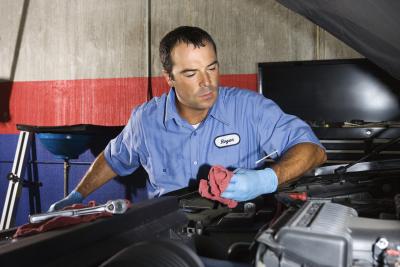
The Dodge Dakota represented the first mid-size pickup manufactured in America during the late 1980s. Although the Dakota has been around over 20 years, it has only seen three generations, with the 3.9-liter, six cylinder engine being one of the standard options for engine sizes until it was replaced by the 3.7 liter in 2005. According to Edmunds, the second generation of the Dakota (1997 through 2004) experienced several reliability issues, which can make the truck difficult to troubleshoot.
Use an OBD II (on-board diagnostics) scanner to retrieve troubleshoot codes from the truck's on board computer. The check engine light typically indicates a problem with sensors or electronics within the engine or braking systems. The truck's OBD II port is located underneath the dashboard next to the base of the steering column. Turn on the OBD II scanner and turn the Dakota's ignition key to the accessories position. Write down the codes from the OBD II scanner and look them up on websites such as OBD Codes or AutoZone. Before replacing a sensor, which can be well over $100 for certain units, use a multimeter to test the continuity of the electrical connection leading up to the sensor. Set the multimeter to measure voltage and turn the key to the accessories position. The multimeter should read between 4.0 and 5.0 volts.
Look up recall and TSB (technical service bulletin) information on your Dodge Dakota 3.9-liter. The second generation, 1997 through 2004, has seen more recalls than other models from the first and current generation of the Dakota. Recalls can be fixed for free by a dealer, while TSBs may give you some clues regarding fixes that relate to some of the problems that you are experiencing. Websites with recall and TSB information include AutoZone and MyCarStats.
Check the fuses for late 1990s Dakota models, if your dashboard or interior lights stop working. Fuses typically protect entire circuits with multiple components or one big engine component. Check the fuse box located underneath the driver's side dashboard and look for any fuses that have broken or burned out terminals. Replace any blown fuse with a new fuse of the same amperage.
Listen for excessive noise, rattling or clicking from the Dakota's suspension. Many second generation models experienced premature front ball joint wear that must be replaced with the lower control arm. If you hear metallic pinging coming from the wheels during turns or periods of acceleration, then your CV joints are failing. Drive your Dakota up on a set of car ramps to inspect the CV boots, which are located behind the wheels. If the boots are cracked or corroded, then the fluid has leaked out of the joints, which need replacing as soon as possible. If you hear a popping noise from the back end of the cab, the sleeves of the cab isolators are too long and need to be shortened by grinding them down.